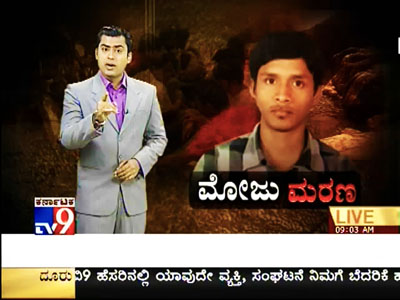Cavalier media prescriptions

 On February 7, 2012, the Bangalore edition of the Deccan Chronicle, using the mishap as pivot, hosted a full page-overview of trekking. The paper quoted an experienced trekker as saying, `` One should never venture into the Western Ghats without taking an anti-snake venom injection as most of the deadliest snakes of the country including the King Cobra are found here.’’ The way this sentence has been worded contains two flaws. First, it runs the risk of erroneously suggesting that anti-venom is a dose of immunisation against prospective snake bite to be taken before trekking in wilderness. Second, even if the reference was to carrying anti-venom along on a trek, anti-venom is not a simple thing to administer for all untrained individuals.
On February 7, 2012, the Bangalore edition of the Deccan Chronicle, using the mishap as pivot, hosted a full page-overview of trekking. The paper quoted an experienced trekker as saying, `` One should never venture into the Western Ghats without taking an anti-snake venom injection as most of the deadliest snakes of the country including the King Cobra are found here.’’ The way this sentence has been worded contains two flaws. First, it runs the risk of erroneously suggesting that anti-venom is a dose of immunisation against prospective snake bite to be taken before trekking in wilderness. Second, even if the reference was to carrying anti-venom along on a trek, anti-venom is not a simple thing to administer for all untrained individuals.Anti-snake venom is a protein in the form of plasma or serum that is generated after giving venom in small doses over a long period of time to horses. According to an official of the Haffkine Institute, a regular pack of anti-snake venom contains two vials, one has the anti-venom powder and the other contains sterile, distilled water to dilute the powder for injection. Unlike before, modern anti-snake venom is polyvalent. The powder is a mix of anti-venom addressing the major poisonous snakes of India.
The majority of snake bites are dry bites. For snakes, their poison is precious. They don’t release it into every victim. The strength of venom and the extent to which it has been injected varies with the snake’s current physiological well being, its mental state, given environment etc. Therefore trained hands typically look for symptoms around the bite and general symptoms to the person. Once the decision to administer anti-snake venom is taken, the normal procedure is to first give a subcutaneous injection with hypodermic syringe to gauge hyper-sensitivity to the anti-venom (the Serum Institute of India on its website has a protocol of questions to ask the patient before administering anti-venom). Reaction to anti-venom again depends on the physiology and the psychological condition of the patient. Based on the outcome, the anti-venom is then administered as an intra-muscular injection or as slow intra-venous drip. The intra-venous route has two advantages – the anti-venom is utilized faster; the process can be monitored. However intra-venous injection is a procedure requiring skill. While administering anti-venom, the patient’s heart beat, respiration etc have to be monitored.
In wilderness first aid, snake bite is a tricky subject to handle because of the range of variables involved. Despite that variability a simple protocol has to be devised for the benefit of an average individual (in both roles – victim and help) who may not be expert snake-handler or expert outdoorsman used to such emergency situations. Professionally taught wilderness first aid courses often teach you what to do after a snake bite but rarely go into the actual administration of the anti-venom because that is seen as an act requiring trained medical skill. In the book on wilderness medicine published by National Outdoor Leadership School (NOLS) of the US, the protocol for treating rattlesnake bite starts with simple cleaning of wound, removing rings and other constrictive items, keeping the limb at or below heart level, keeping the patient quiet, hydrated and comfortable and concludes with one word – evacuate. The Haffkine official said this protocol was relevant here as well; she emphasized the need to immobilize the affected area.
So, should an article for mass readership advise taking anti-snake venom along for a trek or should it say instead, avoid snakes and in the event of bite, follow the relevant first aid procedure and take the patient to the nearest hospital?
On February 7, the Times of India also devoted a full page in its local edition to the mishap. In a grey box titled `Stick to the jungle rules ’ – it was next to a report headlined `Beware of the whims of nature, says forester’ - one of the listed dos was, `` keep a stick and gun in hand to fight any odds.’’ Trekkers sometimes use a stick (they are told not to cut tree branches but pick one up from those already fallen and lying on the ground) or a pre-fabricated aluminium trekking pole for added support while walking. Guns however are not advised as wilderness ethic at any outdoor school for civilians including the government run mountaineering institutes in the Himalaya. Although I shudder to think of it, some people may argue that guns are relevant for the Western Ghats of Karnataka which hold wildlife. But shouldn’t it be individuals assigned to possess fire arms in the forest, like a forest guard, who should do so? Is it responsible to suggest carrying guns without differentiating between civilian trekkers and uniformed forest guards? To its credit, the grey box mentioned that trekkers must take permission from authorities to trek and should ideally engage a local guide. However, on the crucial matter of guns, it failed to pay as much attention.
From these news reports the only clear transgression of law that I could decipher was that the trekkers in question (that is, the group which suffered mishap) had no official permission to be in the forest. In one report, some relatives of the deceased also alleged mischief behind the accident. I left Bangalore on February 10. Over the five days I was there, I got the sense that media coverage of the accident had made it a prominent issue. I wish the media’s recommendations had been better thought through.